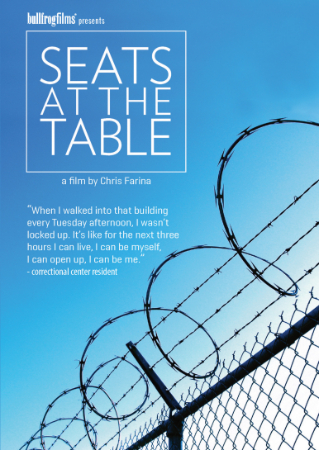
Seats At The Table 2018
Distributed by Bullfrog Films, PO Box 149, Oley, PA 19547; 800-543-FROG (3764)
Produced by Rosalia Films Production
Directed by Chris Farina
Streaming, 87 mins
College - General Adult
Education; Prisons; Social Problems
Date Entered: 01/15/2021
Reviewed by Michael A. LaMagna, Associate Professor & Reference Librarian, Delaware County Community College, Media, PAIn light of recent tragic events in the United States, the focus on criminal justice reform has received significant national attention and is now commonplace in contemporary discourse. In Seats at the Table, director Chris Farina offers a poignant examination of the value education plays in challenging preconceptions many have of incarcerated youths. Following the journey of one section of the Books Behind Bars: Life, Literature, and Leadership course offered through the University of Virginia, this film moves beyond just generalizations to offer a humanizing view of individuals incarcerated at a maximum-security juvenile detention center. While courses and programs like this are not new to institutions of higher education with a mission towards social justice, this film moves beyond depicting the educational experience of the students involved and instead documents the personal growth of those participating in the course.
The film opens with Andrew Kaufman, Associate Professor and Assistant Director of the Center for Teaching Excellence at the University of Virginia, during a pre-course meeting with each group of students enrolled in this course to discuss what they can expect but also to address any questions the students may have about the experience. With the students currently enrolled at the University of Virginia the discussion centers around the issue of power dynamics and the personal reason these students self-selected into this course. The discussion with the incarcerated students centered around expectations and the desire for them to be active and equal participants in the course. Using Russian literature to frame larger discussions about lived experiences for each student it becomes clear that whether they are tradition-aged college students or incarcerated youths there are universal truths. During classroom scenes it is easy to lose sight that the class is being taught inside a detention center.
While the classroom scenes show the humanity of all students enrolled in the class, the value of this film comes from the individual reflections from all students participating in the course. The University of Virginia students discuss their preconceptions and how they changed once they learned side-by-side with their incarcerated classmates. For those incarcerated in the juvenile detention center having the ability to connect with peers in a classroom setting allows them to forget for a moment that they are institutionalized both physically and mentally. Through the experience the idea of identity is explored in the way people are only defined by their worst actions when the human experience is more complicated.
In one scene showing the dichotomy of the experience of the different groups of students outside the classroom, the University of Virginia students are filmed eating at an outside café while the incarcerated students are shown eating in the detention center cafeteria. This scene comes off as disingenuous as the sound was removed from the film when showing the experience of the incarcerated students for more impact. With an absence of ambient noise, viewers will pick up on this and question the decision as it was unnecessary.
As the discussions around criminal justice reform continues to increase, this film offers a good example of the power education has on changing people’s prejudices. This film is recommended for libraries supporting large education programs at the undergraduate and graduate level as well as programs and courses in criminal justice and modern social issues. Additionally, this film provides a good introduction for other students enrolling in a similar course to understand the value of this kind of experience.
Awards:
Finalist, NHK's Japan Prize
Published and licensed under the Creative Commons Attribution 4.0 license. Anyone can use these reviews, so long as they comply with the terms of the license.